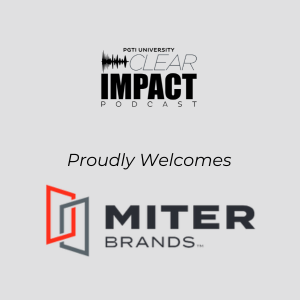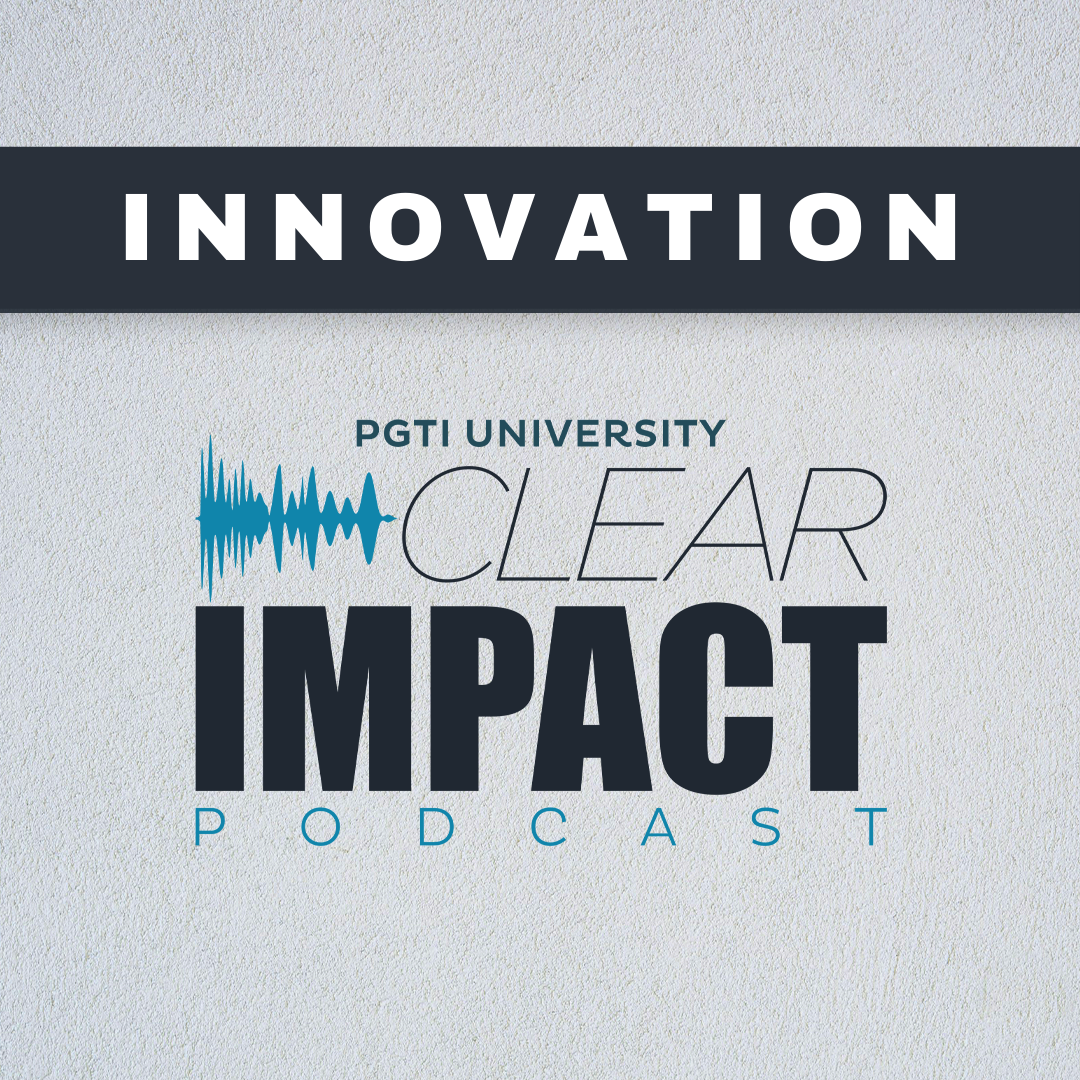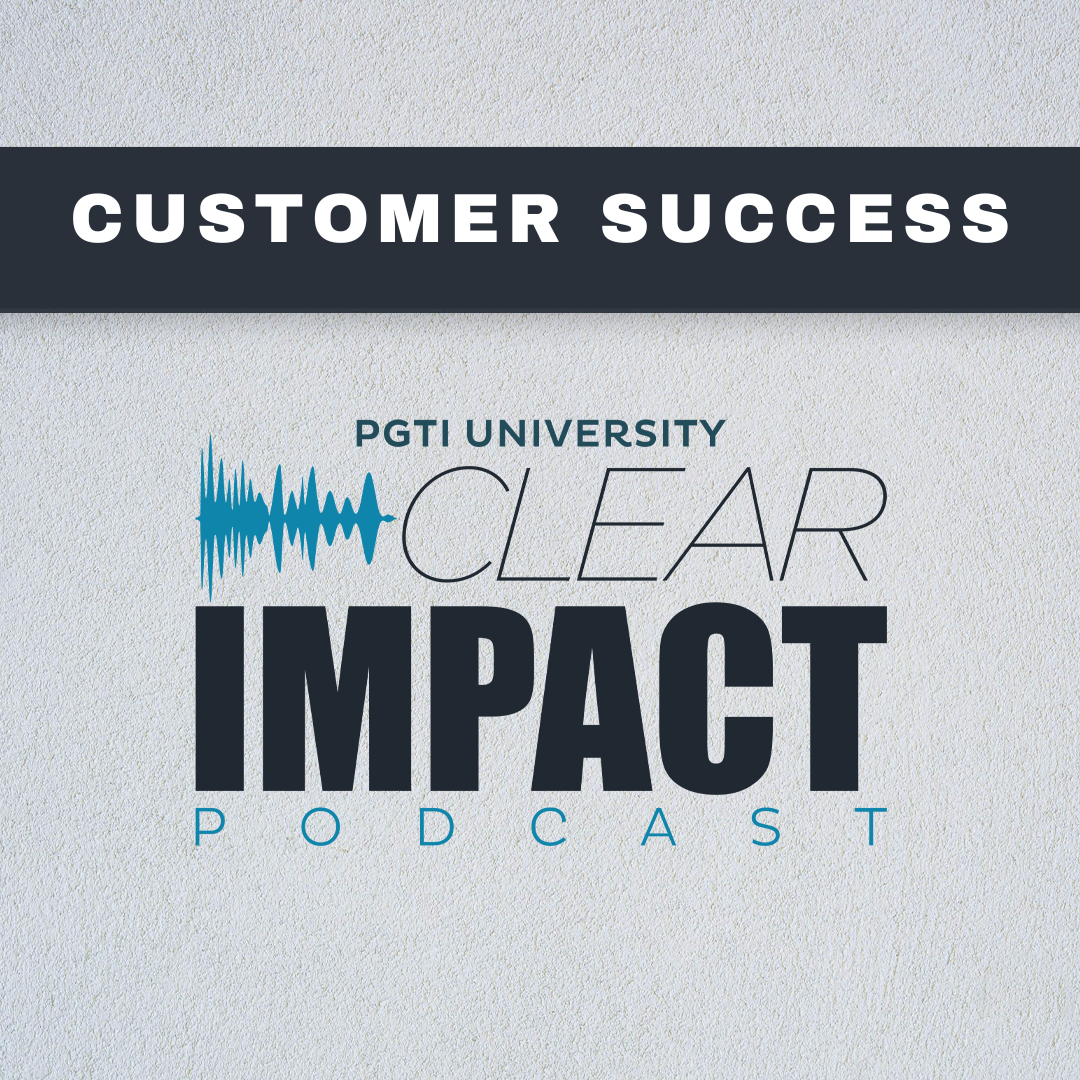Episode Transcript
[00:00:09] Speaker A: Welcome to the Clear Impact podcast brought to you by PGTI University. Thanks for joining us today. My name is Sherri Connor and I am your host.
So good afternoon. We are here on the Clear Impact podcast and we are recording at Anlin Windows and doors today. And we've been here for a couple of days. And so yesterday we had this amazing plant tour from Brennan, who had no idea who Brennan was, just knew he was the guy who was going to work here and going to walk us through the plant and, you know, an engineer of some sort and had this amazing tour, got to see all the different lines, all the different processes, thorough explanation. It was great. And then today I'm like, oh, who.
[00:00:51] Speaker B: Was that guy that gave us the tour?
[00:00:53] Speaker A: And so we're sitting with Brennan Vidmar. I had no idea that you were part of the Vidmar family. And so welcome to the podcast.
[00:01:01] Speaker C: Absolutely. Thank you. Good to be here.
[00:01:03] Speaker B: Yeah, it's good to have you.
[00:01:04] Speaker A: So tell us a little bit about you. Tell us like a little bit of your history, your background and what you do here.
[00:01:09] Speaker C: So I guess we go back a little bit. So I first out of high school, I worked in the family business early on as a punch operator on the production floor after I got my high school degree, went into the navy for four years, did my term there on a couple different aircraft carriers with a couple different tours, came back to Hamlin as a machinist in the machine shop at that time and kind of worked my way through the engineering roles. We didn't really have a big engineering department, frankly. On paper, it didn't even exist. It was just under maintenance. And today, about twelve years later from that, we have a full blown engineering department with manufacturing engineering, product development, R and D, manufacturing engineering. And then the tool shop is a full fledged machine shop now that supports the entire division.
[00:01:57] Speaker A: Wow. And so what is your role today?
[00:02:00] Speaker C: So my role, I'm the chief engineer. So I run all those departments, the maintenance, manufacturing, engineering, product development and tooling departments. So I work concurrently with Bryce and Mike Roy on various projects, whether it be new products or enhancements, along with ensuring that our production processes are state of the art and meeting those quality expectations that we have for the inland brand.
[00:02:25] Speaker A: Wow. So just a little bit of work?
[00:02:28] Speaker C: A little bit. It's just a couple hours a day.
We definitely like to keep it very fast paced around here. So there's definitely no shortage of work.
[00:02:37] Speaker A: Yeah, I understand that too. Wow. It's all making sense now because I did not understand this yesterday. I didn't get who you were, because one of the things that we did on our tour, because there was a lot of congestion through one of the normal pathways, is you took us through the tool and dye room. And I find that to be such a fascinating space because we have that at PGT as well. And I didn't really understand what all of that was or what it meant. And so one of the engineers in that space is my buddy. And so I was like, can I just, like, go see what you guys do down there? And it's not something that we would tour people through, but I was completely blown away by the whole process of what goes into taking a hunk of metal, and then you turn it into a tool, and then you put it into a machine that then punches all the extrusions. Right.
[00:03:21] Speaker C: It is amazing. The tool shop from when I first started, we had some manual machines. We had one old 1985 CNC machine in the back. And that was our tool shop just 1012 years ago. And you look at it today when you walked in, we have three full blown VMC machining centers. We have the CNC surface grinder. We have a lot of automation that allows us to produce really top notch, high quality tooling that we need in order to produce our products. And when we were acquired just a couple years ago, western saw what we were doing. And we've been actually supplying some tooling for the western division because we have the capability to do so. And having that capability in house is huge. We can react extremely fast. If there's a problem on the floor, the production staff can make a call to my team, hey, I have this issue on this punch or this guide or this fixture, and we can react immediately. Before we had full capability, it was very difficult to keep production running in some instances, because you're at the mercy of the exterior suppliers. And sometimes, oh, yeah, I get to you maybe tomorrow. I'll get to you maybe next week. And it was very difficult sometimes to keep production running because you were at the mercy of those suppliers. And if you look at our process now in the tool shop, we're producing 100% of our punch tooling now in house.
[00:04:38] Speaker A: Yeah, we have that same model, and that same exact reason is that we want to control what we can and not rely on outside vendors where it makes sense, you know? So, like, we don't do our own screens today, but you guys do. But you guys do your paint. We don't need paint. So it's just interesting to observe the differences and the similarities, you know, where it really counts. And you've been to Venice, right? You were there last year, earlier this year?
[00:05:02] Speaker C: No, actually, just a couple months ago.
[00:05:03] Speaker A: Actually, just a couple months ago. And so you were checking out some different paint processes on the black and black, the cap stock product? That's correct. Okay. And so it's just cool to see the differences. Right. And so do you work with Kevin Vilhauer, then?
[00:05:16] Speaker C: Yes, I do. At Kevin Vilhauer, we work pretty closely on a lot of the product development, R and D specific projects. So I've been working with him, really, since he came on board, and we've been developing our working relationship and really trying to figure out how to best utilize both of our teams to not only make sure that Amlin and Western is good, but how do we really press forward as a team in order to better the entire division? So it's something that's ongoing and things that we're working through to really utilize all of the resources that we have to really press us forward.
[00:05:46] Speaker A: All right, so you didn't have any prep on this. So we'll toss this if you don't have an answer. But I bet you do have an answer, because you seem like a pretty sharp guy. So one of the things I love to ask leaders is around the topic of advice. And so what is a solid piece of advice that you've received somewhere along the line?
[00:06:03] Speaker C: You know, one of the solid pieces of advice is, if I were to look back, I'd say, it's my grandpa. And one of the things that he would always say is, when it comes to working with people, it's, you want to give people their opportunity, give them their chance. But what I found interesting is he always said, you give them their opportunity, and if they falter, you give them a second opportunity, but you don't give them the third opportunity. Now, I thought it was kind of odd when he said that. It's like, okay. But I think what he was trying to say is, you want to work with people and develop them. And if they obviously can't work forward, then you need to make a decision and either move on or change your strategy. And it was really a lesson in looking at who you're working with, is what I'm doing helping develop them into something that works for the organization, works for a really department, and is something that is going to be fruitful for everybody. So it was interesting when he said that initially because I didn't quite understand what he was saying.
[00:07:00] Speaker A: Well, and you can't want it more for them than they want it for themselves.
[00:07:03] Speaker C: That is true.
[00:07:04] Speaker A: So you can give that second chance, but at some point everybody has to carry their own load, right?
[00:07:09] Speaker C: I mean, that's the biggest thing. And right now I'm fortunate enough to have a very, very solid team, very driven team, really, in every one of the departments. And the good thing is my team seems to be aligned with not only my vision for the department, but really, I think what we're doing as a company. And I'm very thankful that I have such a great team to be able to work with to accomplish our mission.
[00:07:31] Speaker A: That's awesome. Well, I am just thrilled to finally be out here and to get to meet some of the folks here and you guys are living up to your reputation. You know, we've heard great things about the team at Anlen and just the culture and the family environment, and it's absolutely holding true. So now for sure.
[00:07:47] Speaker C: And that's really why I've been in Amlor for so long. Cause we've had that family environment, we've worked together. The communication is big for me, making sure that everybody understands what we're doing. You know, there's obviously some room for improvement, even on my end. I'm not gonna say I'm perfect by any means, but having that collaborative environment, having those relationships, having that family environment between each other and even the departments really is what makes Anlin Shine and is the reason I'm here.
[00:08:15] Speaker A: Well, I am thankful for your time today. I know you've been dealing with a lot. You've got some rearranging out there on the floor and new equipment coming in or, I mean, we have the same things going on at PGT, so it's. For sure it's a busy time for manufacturing.
[00:08:28] Speaker C: It is the end of the year sprint again. The equipment installs, line layout improvements. A lot of the end of the year initiatives are really kicking in high gear now. So we definitely have our work cut out for us for the rest of this year.
[00:08:40] Speaker A: Well, tell Mark if you're a little bit behind schedule, it's because I roped you into a podcast.
[00:08:45] Speaker C: I will definitely let him know.
[00:08:47] Speaker B: PGTI University is the customer education team for an entire family of brands. We began with the original easy Breeze porch enclosure line, then became PGT, America's leading brand of impact resistant windows and doors. We then added CGI, CGIC, Windoor western window systems, new south windows, echo windows and doors, Anlan windows and doors, and our latest acquisition, Martin Garage doors. We create products built to withstand major storms, keeping people safe, secure and prepared. Our exceptional brands give you the protection you need without compromising design or functionality. PGTI University is here to educate you, our listener, so that you can be a more informed consumer of window and door products.


